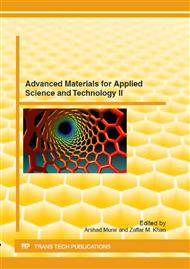[1]
A. P. Mouritz, K. H. Leong and I. Herszbeng. A Review of Effect of Stitching On In-Plane Mechanical Properties of Fibre-Reinforced Polymer Composites, Composites Part A 1997; 28 A: 979-991.
DOI: 10.1016/s1359-835x(97)00057-2
Google Scholar
[2]
A. P. Mouritz, B. N Cox, A Mechanistic Approach to the Properties of Stitched Laminates, Composites Part A 2000; 31: 1-27.
DOI: 10.1016/s1359-835x(99)00056-1
Google Scholar
[3]
Bhavani. V. Sankar, Huasheng. Zhu. The Effect of Stitching on the Low-Velocity Impact of Delamination Composite Beams. Compos. Sci. Technol. 2000; 60: 2681-2691.
DOI: 10.1016/s0266-3538(00)00132-9
Google Scholar
[4]
J. hertz, J.L. Christian, and M. Varlas, et al., Advanced Composites Applications for Spacecraft and Missiles. phase I, fila report, AFML-TR-186, Vol. ΙI, general dynamics-Convair Division, San Diego California, (1972).
Google Scholar
[5]
Yanmei Li, John Miranda, Hung Sue. Hygrothermal Diffusion Behavior in Bismaleimide Resin. Polymer 2001; 42: 7791-7799.
DOI: 10.1016/s0032-3861(01)00241-5
Google Scholar
[6]
Li-Rong Bao, Albert F. Yee. Effect of Temperature on Moisture Absorption in A Bismaleimide Resin and Its Fibre Composites. Polymer 2002; 43: 3987-3997.
DOI: 10.1016/s0032-3861(02)00189-1
Google Scholar
[7]
Li-Rong Bao, Albert F. Yee. Moisture Diffusion and Hygrothermal Aging in Bismaleimide Matrix Carbon Fibre Composites—Part I: Uni-Weave Composites. Compos. Sci. Technol. 2000; 62: 2099-2110.
DOI: 10.1016/s0266-3538(02)00161-6
Google Scholar
[8]
Li-Rong Bao, Albert F. Yee. Moisture Diffusion and Hygrothermal Aging in Bismaleimide Matrix Carbon Fibre Composites: Part II—Woven and Hybrid Composites. Compos. Sci. Technol. 2000; 62: 2111–2119.
DOI: 10.1016/s0266-3538(02)00162-8
Google Scholar
[9]
Pavankiran Vaddadi, Toshio Nakamura, Raman P. Singh. Transient Hygrothermal Stresses in Fibre Reinforced Composites. A Heterogeneous Characterization Approach. Composites Part A 2003; 34: 719-730.
DOI: 10.1016/s1359-835x(03)00135-0
Google Scholar
[10]
J.S. Earl, R.A. Shenoi. Hygrothermal Ageing Effects on FRP Laminate and Structural Foam Materials. Composites Part A 2004; 35: 1237-1247.
DOI: 10.1016/s1359-835x(04)00121-6
Google Scholar
[11]
Chen Gang. Study on Mechanical Properties and Structure Design of Stitched Laminates, Dissertation for PhD degree Beihang University, (2004).
Google Scholar
[12]
Gui LJ. Study on The Basic Mechanical Properties and Impact Damage Resistance Properties of Composite Laminates. PhD thesis, Beijing University of Aeronautics & Astronautics, (2000).
Google Scholar
[13]
Camanho P. P. and Matthews F. L., A Progressive Damage Model for Mechanically Fastened Joints in Composite Laminates. J. Compos. Mater. 1999; 24(33): 2248-2280.
DOI: 10.1177/002199839903302402
Google Scholar
[14]
Cheng Xiao-Quan, Li Zheng-Neng. Damage Progressive Model of Compression of Composite Laminates After Low Velocity Impact. J. Appl. Math. Mech. 2005; 26(5): 618-626.
DOI: 10.1007/bf02466336
Google Scholar
[15]
Camanho, P. P. and Matthews, F. L., Delamination onset prediction in mechanically fastened joints in composite laminates [J]. J. Compos. Mater. 1999; 33(10): 907-927.
DOI: 10.1177/002199839903301002
Google Scholar


